Since the arrival of Pep Guardiola football as a manager, a lot of discussions have been regarding his football philosophy. Tiki-Taka, Total Football, and Possession are some of the terms that people use to characterize it. Positional Play is the right way to describe it.
“Move the opponent not the ball”
Pep Guardiola
The above quote describes in the clearest way his football coaching philosophy. It’s not about possession it’s about the position. Pep’s style of playing is Positional Play. Thomas Tuchel, Mauricio Pochettino, and Roberto De Zerbi are some of the most well-known coaches who are using Positional Play. A coach can interpret Positional Play, like other styles, in different ways. Whatever the coach will choose, the main principles remain the same.
For coaches in Spain and the Netherlands Positional Play (“Juego de Posicion”), is a philosophical ideal that few know how to coach. But, what is “Juego de Posicion”?
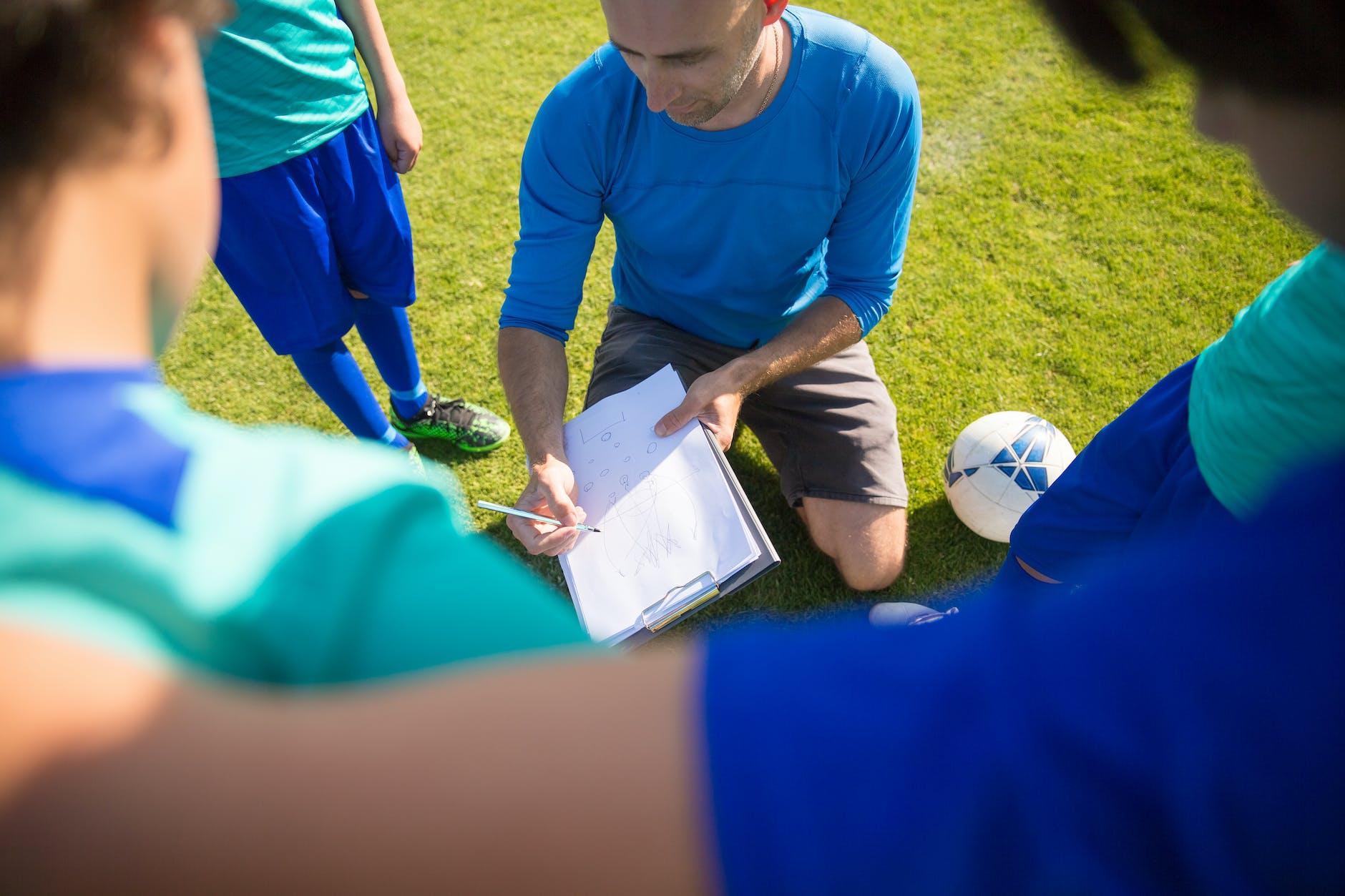
Elevate Your Coaching Journey
Are you ready to take your coaching career to the next level? Look no further than FootballCoach365, your ultimate destination for top-notch coaching material.
Join the Coach’s Corner today and experience the transformative power of proper planning, training and coaching.
Possession as a tool and not as the main objective
The fundamental reason behind the high possession percentage of “Juego de Posicion” is that the rotation of the ball is the main tool to disorganize the opposition’s defensive structure. The aim is to force the opponents to leave their positions, create gaps, and forward. You force the opponent to shift, attract him with the ball, and create free spaces behind their lines. “Dominating possession” is not just a Spanish or Dutch playing philosophy, but a tool of “Juego de Posicion.”
In cases that a passing combination doesn’t work, the team may circulate the ball for a moment without attempting to attack to regroup, take shape around the opposition, and try again.
Possession is not an attacking or defending strategy in itself but a way of controlling the game. Controlling the game doesn’t mean having more possession than the other team, it means keeping the ball in the other team’s half for the majority of the game – keeping the ball in one’s half is useless and dangerous.
How to Train Positional Play – 15 Exercises from Theory to Practice

“The objective is to move the opponent, not the ball” – Guardiola
- What is Positional Play?
- What is the Guardiola Grid?
- Third Man Concept
- Half Spaces
- 15 Positional Play exercises
COACHING POSITIONAL PLAY – “EXPANSIVE FOOTBALL” ATTACKING TACTICS & PRACTICES

Learn to Coach Positional Play with the Spanish Game Model of “Expansive Football”, Attacking Tactics & Practices
- Positional Attacking
- Developing an Effective Attacking Tactical Game
- Methodologies to Use in Training
- Teamwork and Collaboration
- Competitiveness and Desire to Win
- The Methods of Training
- Putting the Theory into Practice with “Expansive Football”
Positional Play is primarily an Offensive Concept
Positional Play comes down to giving the team, especially during the attacking phase, a set of guidelines to play within a structured organization. The coach usually divides the playing field into specific zones, with vertical lines and some horizontal lines. It can be simple or more complicated depending on the coach’s philosophy.
Below is an example of the divided pitch Pep Guardiola uses for his training. A coach, based on his philosophy, can divide the pitch in any vertical or horizontal arrangement depending on his game plan.
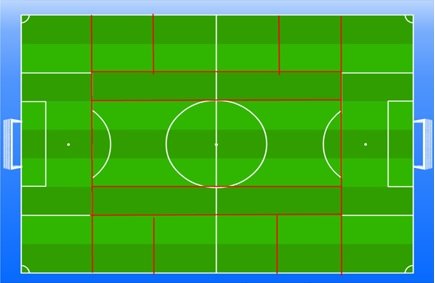
All the training – tactical designs were build with the Tactics Manager by Soccer tutor. Check it out.
The players will have specific tasks and responsibilities within these zones depending. Of course, their duties have to do with the phase of the game (attacking, defending, or transitioning). The unique thing about this concept is that the options are predetermined by the position of the ball but at the same time, it provides multiple options for the player to take. This is heavily affected by the player’s decision-making ability.
For example, if the ball is on the wide right corridor in the defensive half, then the zones that must be occupied are entirely different than when the ball is on the left internal corridor in the opponent’s half. The team must use continuous ball-oriented shifts when in possession. These shifts must be by the ball possessor. In this way, players can offer him different passing options or clear space for him to progress up the field. Short passes, switched balls, and the rotation of the ball’s position are all important tools. They can define the complex positional tasks assigned to the players.
Guidelines
There are also guidelines for this. Triangles and rhombus are the shapes a team is looking for to maintain short-passing combinations. The ball possessor should have two or, ideally, three passing options (in diamond rather than triangle shapes) nearby.
Additional further-away passing options are mandatory for two reasons:
- To keep opponents away giving enough space for the player on the ball and near teammates to operate
- To give an option for a switch of play or long ball in case of emergency
Pep Guardiola uses very simple guidelines when he trains his players on the gridded pitch: No more than three players may be in a line horizontally and no more than two players in a line vertically. If a player moves onto the same line as another player to offer himself a pass, the other must move to another line.
By doing so, you can pass around the opponent or draw him in and then shift. At Manchester City, you can see this on the external corridors; if Mahrez or Greelish stays on the touchline, then the full-back indents or pushes inward. However, if the full-back pushes to the wing, then the winger moves toward the half-space. This ensures the nearest eight or the defender at the back always has two passing options.
Check below an animated video on how to utilize the half-spaces.
For more animated videos visit the FootballCoach365 Youtube channel
The pass patterns, the formation, and the tasks of the ball possessor and the players near the ball depend on the playing philosophy of the coach. Thus, in addition to the positions occupied and the short passes, the possession and rotation of the ball are crucial.
The three P’s that characterized positional Play: Possession, Position and Pressure.
- Position: the location of the players on the field. The position is always related to the teammate and opponent’s position and where the ball is located.
- Possession: related to protecting the ball by circulating it. The team that has the ball usually controls also the game.
- Pressure: immediate recovery of the ball when it’s lost.
The relationship that exists between the above three concepts is significant: The position of the payers on the playing field makes it possible to optimize efficiency in the possession and recovery of the ball.
Key points
These concepts are achieved by keeping with the following key points
- Creating width and length: Making the pitch as big as possible allows players to stretch the opposition’s defense and give more free space to players in the middle. Also, it enables more switches in play
- Generating the ‘third man’: Through the use of passing, rotation of positions, and by having players coming down or up into midfield, a free man, the “Third Man” can be found to advance the ball forward.
- Positioning at different levels/lines: Ensuring players are positioned at different lines instead of at the same horizontal or vertical line provides greater passing options and disrupts an opposing defensive structure.
- Playing in-between the lines: By having players in-between the lines, usually the most creative ones, the ball can be advanced behind the opposing line of pressure gradually and in control.
- Moving as a block when attacking or defending: Keeping the team as a block ensures that all players can participate in the attacking or defending duties and also ensures better behavior in situations of transitions.
- Immediate pressure upon losing the ball – counterpressing: The best moment to win back the ball is upon losing it as the opposition has not yet transitioned to an attacking mentality and shape. Immediate pressure requires a collective effort. Jurgen Klopp based his whole philosophy and coaching success on the counter-pressing, his famous “gegenpressing“. Check the Coaching Voice post on Counter-pressing and gegenpress.
- Creating 1v1 situations: To generate qualitative superiorities a team must create 1v1 situations with its best players. This must be accomplished frequently whether it be in the traditional areas out wide or in midfield.
General Principles:
The nature of these interactions is in groups, whether that’s a small number of players or the entire team. Hence, the whole team should be on the same page when applying the aforementioned tactics. The following points and concepts are checkmarks that allow the manager to steer the team in the right direction. Bearing them in mind facilitates the organizational and evaluation processes that go along with designing sessions.
- Continuous Spatial Distribution
When evaluating the play of the team, this should be the first metric to judge whether the team is on the right track toward implementing a successful positional play system. The spatial distribution is how well the team can maintain its shape and structure.
- Spatial Awareness:
If players are instinctively able to examine their surroundings, and consequently change their positioning to give the team the correct spatial distribution, then this is a sign of cognitive development. Players should consider their teammates, along with opposing defenders. When they are too close to their nearest teammate or the defender is marking them very closely, they should instinctively move a few meters in the correct direction.
- Ball Circulation
Ball circulation is a fundamental tactical element in the development of positional play. Moving the ball through the team’s structure creates gaps and spaces for the team to attack the opposing goal. However, the team must never pass the ball simply to pass. The right conditions (2v1’s, correct body positioning, receiving in between lines or positions, etc) should be in place before the pass is executed. Every passing action should have continuity in the game.
- Generating Superiorities
When we talk about being superior or inferior, most people tend to directly go to the quality. We associate being superior with being better, although to be better in itself does not mean anything and we must be more specific. For superiority to mean anything, they must provide the team with some advantages over the other side.
Paco Seirul•lo, along with many other brilliant coaches who delve into positional play, classifies superiorities into four categories: numerical, positional, qualitative, and socio-affective. To restrict this article to the tactical aspect of the style, we will exclude socio-affective superiority. That isn’t to say it’s not important, on the contrary, it’s highly significant to the social aspect of the game, and for that reason, it requires an entire post about it apart from this one.
Numerical
As the name might lead you to believe, numerical superiority refers to the relationship between the team’s players and opponents in a given zone or space. This is the simplest superiority to identify in a match. It requires no context. Anyone can easily distinguish it from a screenshot at any given moment of a match. Creating it on the other hand is much more difficult and calls for continuous movements and correct positioning along with each player meeting their responsibilities.
Football is played with eleven players on each team, therefore in theory there should never be numerical superiority. However, due to the laws and regulations of the game, the defensive team always tries to protect their goal, consequently placing more players in their defensive third to protect their goal.
Let’s imagine in a match both teams are using a traditional 4-4-2, and each player plays in their given position. The back four stays in their defensive third, the midfielders stay around the middle of the pitch, and the two strikers stay further up the field. If both teams played this way, the two strikers would always be outnumbered and the midfielders would always be in numerical equality. The result of such a situation would most likely be one of the most boring matches you’d ever seen.
Thankfully for us, football’s pioneers devised plans and tactics that deviated from these traditional ways of playing and realized they could move players around and position them differently to break the continual numerical inferiority and equality. Breaking the field of play into zones, and in those zones breaking the sequence of events into small-sided games, they were able to see that teams could create 2v1, 3v2, and 4v2, to progress up the pitch.
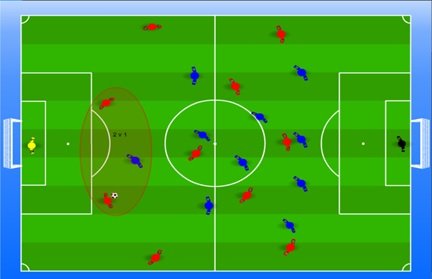
Example in a Build up situation
Let’s use as an example the build-up from the defensive third. Firstly, the goalkeeper needs to participate and be considered a field player just like anyone else on the pitch otherwise, the team in possession will always be, in the best-case scenario, in numerical equality. Secondly, the center backs must dribble to attract a defender, to draw them out. Synchronously, another player, preferably a midfielder must support the ball possessing center back. These two players have just created a simple 2v1, and if executed correctly, they should be able to progress up the pitch. The following image depicts the situation.

This is just one way that a team can create numerical superiority, furthermore, this advantage can occur anywhere on the pitch. As you can see in the following video, numerical superiority can happen anywhere and will involve different amounts of players.
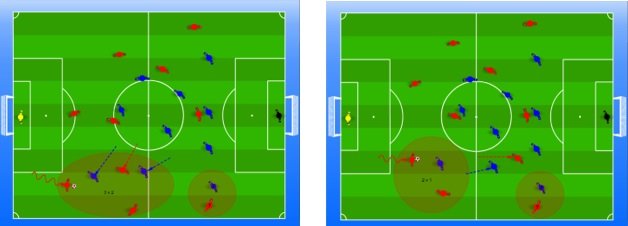
As we have mentioned before, all players are involved either directly or indirectly in all 4 phases of the game. In the above figure, #7 (winger) does not have a direct relationship with the ball carrier. That does not mean his role is not important. His role is to stay high and wide to keep the opposition Left Back occupied and to allow the red center-back, Right Back, and Attacking Midfielder to create a 3 v 2 overload to the sides.
Salida Lavolpiana
A classic example in the search for numerical superiority in Positional Play is called “Salida Lavolpiana,” or “The way out of La Volpe.” This is a variation of progressing the ball out of the back in possession. Many times Pep will have players drop into the defensive line if the opponents pressure with the same number of attackers as Pep’s defenders. The value of this idea is mentioned here by Lillo:
“Positional Play consists of generating superiorities out of the defensive line against those who are pressing you. Everything is much easier when the first progression of the ball is clean.”
Juan Manuel Lillo

Using the goalkeeper is also another way to establish superiority out of defense, progress past the opposition lines, and move up the field to create an advantageous attack. Salida Lavolpiana is a variation in which the central defenders fan out wide and a central midfielder drops into the resulting space. This briefly creates a back 3 in addition to having the goalkeeper as a base for the progression of the ball.
“Although in Spain it became common in the 2009-2010 season of Josep Guardiola with FC Barcelona, it is in Mexico where this concept is used most. La Volpe practiced this with his teams since the mid90s, including the Mexican National Team during the time when Guardiola played for Dorados de Sinaloa, during a time when the Catalan coach could approach La Volpismo.”
Marti Perarnau
This is used most often when an opponent pressures 2 central defenders with 2 strikers. In our day a lot of teams adopt a formation of 4-4-2 in the defensive phase. This is to press high the 2 defenders in the opponent’s buildup phase. This movement creates a 3 vs. 2 situation out of defense, meaning a free man is available. The fullbacks push up into midfield as the central defenders fan out not only to provide a pass option but to provide numerical superiority in midfield as well. This ascending superiority provides an advantageous path toward the opponent’s goal. Juan Manuel Lillo mentions this as one of the principles of this style of play:
“Pass to the next lines of play.”
Juan Manuel Lillo
Positional
As mentioned in the above quote by Paco there is another form of superiority besides the 2 already mentioned. This is a superiority of space or positional superiority. In this form of play, the players are arranged at various heights and depths. This staggering creates interior corridors and passing lanes within the opposition’s formation. There is a large focus on the spaces “in between the lines.” Players look to position themselves in areas between the opponent’s horizontal and vertical lines of defense.
There are specific zones that must be occupied by players at specific moments. The specific zones or positions that must be occupied depend on various circumstances. A certain set of players within the team occupy the specific zones about the ball, though the players who do this can vary because of the flexible interchanging of roles. A player determines where they will move by referencing the position of the ball, their teammates, the opponents, and space. Arrigo Sacchi made a similar point when speaking about the defense of his great AC Milan team:
“Our players had four reference points: the ball, the space, the opponent, and their own teammates. Every movement had to happen in relation to these reference points. Each player had to decide which of these reference points should determine his movements.”
Arrigo Sacchi
To have a positional advantage to be better positioned than the opposing team. The objective is to be in a good position to attack or counter-press. Positional superiority is slightly more difficult to identify and requires more context within the match.
Offensively, the objectives are to retain possession, progress up the pitch, and ultimately score a goal. Defensively, a team wants to win back the ball. Another task is to deny any opposing progress up the field and avoid any goal-scoring opportunities. From this point of view, positional superiority would be to situate oneself in a position to gain a specific advantage over the opposition.
A coach can achieve that through several individual techniques. The most common one is body orientation. This is the way that a player is facing, not only their eyesight but his general body. Every coach knows whichever way your hips are facing is the direction that you are going to take your first step. Yes, you can run backward and sidestep, but if you are going to run with speed your hips need to be facing the direction that you are going to run. For this reason, body orientation is crucial in positional play.
Along with body orientation, there are other ways to achieve positional superiority. For example, the path of supporting runs, checking or breaking, influences the positional advantage heavily. As coaches, we’ve all taught our players that they should be making curved runs into the penalty area. But for sure most coaches have never wondered why. It’s for exactly this purpose. To try to meet a cross perpendicular is much more difficult than to meet it almost parallel via a curved run.
Qualitative
Another form of superiority is qualitative superiority. This is an idea that is well known. Searching for 1 vs. 1’s, 2 vs. 2’s, and more with your best players vs the opponent’s worst players is a common strategy in football. This is perfectly exemplified in this quote by Paco Seirul-Lo:
“There’s numerical, positional, and qualitative superiority. Not all 1 vs. 1’s are a situation of equality”
Paco Seirul-Lo
Qualitative superiorities are the advantages that require the most context and specific understanding of players’ skills. To put it simply, it’s when one player or group of players are better than their direct opponent. Imagine a 1v1 between a very skillful winger and a slow, clumsy center back. Most likely the winger would get past the defender nine out of ten times. This is the premise of qualitative superiority. The knowledge that one player will be better than another in specific moments of the match.
“A team with a good collective idea but lacking skillful players, they can’t be champions. However, a team with very skillful players but an awful collective idea, it’s possible for them to be champions.”
Angel Cappa, legendary Argentine manager,
Qualitative superiority can explain this phenomenon. Imagine you have a skillful team. Even if the players are putting themselves in numerical and positional inferiority situations, through qualitative superiority they can escape.
We have seen this many times when Messi, Cristiano, Pele, Maradona, Zidane, Ronaldinho etc, seem to be in situations where it’s unfathomable they will find success, yet they manage to break out magical moments and succeed. This is qualitative superiority
Of course, you are most likely never going to coach a talent like the players I’ve mentioned, but that doesn’t mean you can’t create this type of advantage on the field. It’s just a matter of having a clear understanding of your players’ skill sets and exploiting them. For example, if you have a winger who is masterful in one-versus-one situations, then you might create an overload on the opposite side to isolate him and let him prosper once you get him the ball. Maybe you have an extremely tall striker; you might play in the wings and look to find him in the penalty area even when he is outnumbered.
Not only can this be done to accentuate your players’ strengths, but you can look to pinpoint the opponent’s weaknesses. Along the same lines, you might look to attack the center back who lacks the speed or force the opposing team to play in the air when they lack in that department. It’s just a matter of analyzing and exploiting the advantages.
Socio-affective
Paco Seirul-lo’s Socio-Affective superiority states the importance of identifying/developing the general understanding between the players (Garcia, n.d.).
The players due to their connection (socio-relationship) can interact better, faster, and more efficiently than their opponents. That requires a high level of mutual understanding between the players and only teams with strong bonds can truly master this kind of superiority.
This is the slowest superiority to develop. It requires clear game principles set by the manager/club to develop team communication.
These players showed their understanding of each other through their associations on the pitch. They all “spoke the Barça language” and it showed. This is communication at the team level.
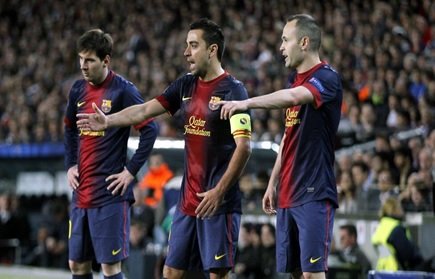
Alex Ferguson was a master at creating Socio-Affective Superiorities. He developed consistent principles and core practices within the Manchester United organization throughout his long tenure.
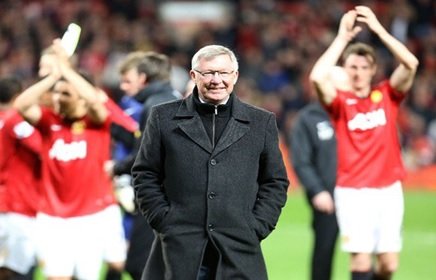
This is why national teams with individually talented rosters can perform poorly while smaller countries perform better at the international level because there is less variety (fewer clubs, more common principles) within the country. An example is Iceland. Their national team had impressive results the last few years even though their national championship is of a low quality.
All the above superiorities take place near the ball possessor area. In simple words, the superiorities are:
- Numerical (“there are more of us”)
- Positional (“we have a better position”)
- Socio-affective (“we understand each other better”) or
- Qualitative (“we are better”) superiorities according to each player involved in the intervention space (Peñas, n.d.).
Third Man
This article regarding positional play would not be complete without introducing the concept of the third man.
The main objective of Positional Play is to find the Third Man which is usually a “Free Man”. To find players behind the lines of pressure by creating positional superiorities. These positional superiorities are created by enforcing strict positional restrictions and responsibilities.
Below is an animated passing drill for Third Man runs.
The Catalan midfield maestro, Xavi Hernandez, once described the concept of the third man using a tactic that Pep’s Barça utilized frequently.
“To look for the free man is, for example, the center backs have the ball and one of them is always free because you always have more defenders than strikers. In this case, Puyol dribbles up with the ball until an opponent steps up to him. If my mark is the one that tries to stop him, then I become the free man. If Iniesta’s man steps up to him, then Andres becomes the free man. And like that, we look for superiority in any area of the pitch. You create three versus two, you win it, and now you have a free man. We advance up the field.”
In that short passage, Xavi describes how the previous superiorities are the cornerstone of this concept. Creating a three versus two situation is numerical superiority. Positioning themselves behind their marks to progress demonstrates positional superiority. Of course here, the qualitative superiority appears also.
These underloaded areas are the least important for immediate play, though they also play a role. Guardiola’s teams seek to have superiority in the center of the field. Permanently occupying the center means that players always have an option to pass to. How Guardiola’s players support each other means that the player will always have at least 2, and preferably 3, passing options.
These superiorities or overloads provide interesting effects in the game. Combinations become tighter and quicker when space is overloaded. It’s possible to break through the defense on the near side of the field, to open spaces on the far side of the field, and it allow for a stable possession.
A simple passing drill is always a good way to train the midfielder’s movements without the ball. The drill can help a coach train his players to search for and find the third man, the free man.

Conclusion
As you can see, Juego de Posicion is an interesting offensive concept that is often neglected in many other countries. Every coach has his mechanisms and can install his patterns into the structure. The basic ideas can also be used in defense.
Coaching this style is complex. The trainer must be aware of the impact of the ball’s position on the structure of the game. Also, it’s important to know the characteristics of his players to design the formation, processes, and tasks; not to mention how he will coach them. A coach has several tools for training the concept. Among others, verbal coaching, using lines painted on the field, designing situational exercises, and training games are the most important.
Did you like what you read? Also, check out the books below:



